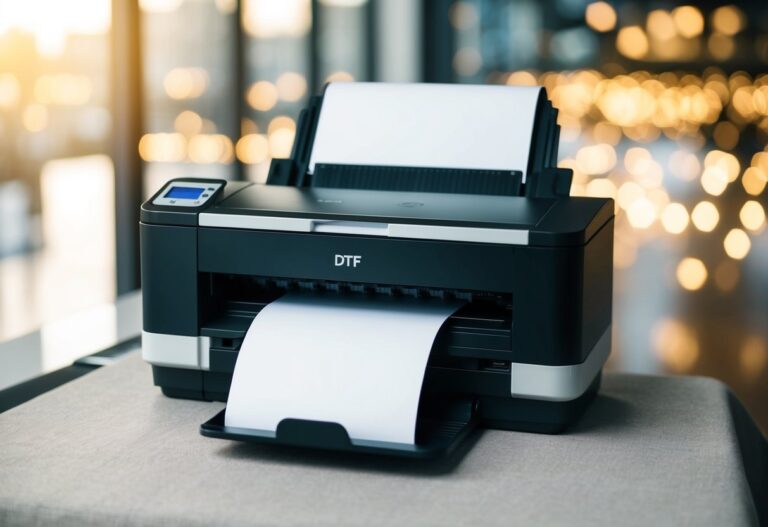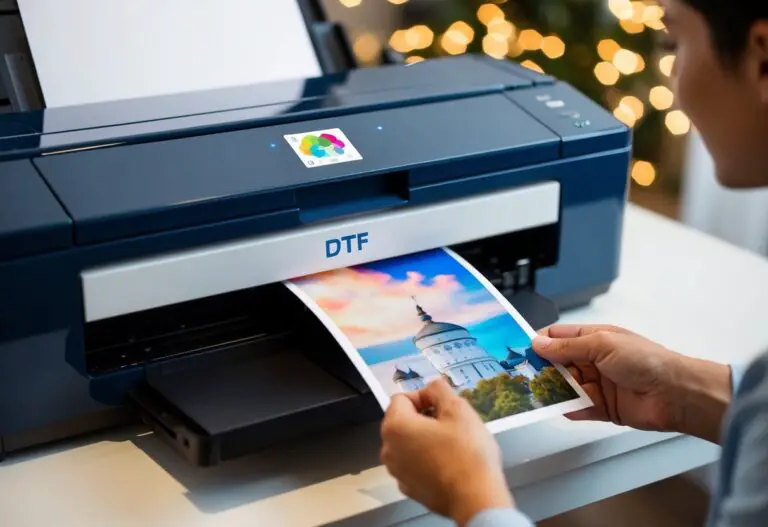DTF printing has revolutionized the custom apparel industry. You might wonder if this amazing technology can print white ink. The answer is yes! DTF printers can print white ink, allowing for vibrant designs on dark fabrics and materials.

White ink is a game-changer in DTF printing. It creates a base layer for other colors to pop on dark garments. You can also use white ink on its own for crisp, clean designs. This ability opens up a world of possibilities for your custom printing projects.
While white ink printing with DTF is possible, it does come with some challenges. You might face issues like clogged print heads or uneven coverage. But don’t worry! With proper maintenance and techniques, you can overcome these hurdles and create stunning white prints.
Key Takeaways
- DTF printers can print white ink for vibrant designs on dark fabrics
- White ink serves as a base layer and can be used alone for crisp designs
- Proper maintenance helps overcome common white ink printing challenges
Can DTF Print White?
Yes, DTF (Direct to Film) printers can definitely print white. This is a key feature that sets DTF apart from some other printing methods.
DTF printers use special white ink as a base layer. This white ink goes down first on the transfer film. It helps your designs show up clearly on dark or colored fabrics.
You’ll find the white ink super helpful when printing on non-white shirts. It makes your colors pop and ensures the design is visible against any background.
Here’s how DTF white printing typically works:
• White ink layer prints first
• Color inks print on top of the white
• Transfer film is powdered and cured
• Design is heat pressed onto the garment
DTF’s ability to print white opens up lots of design options. You can create vibrant full-color images on dark shirts. Or print crisp white text and graphics that stand out.
Some other printing methods struggle with white ink. But DTF handles it well. The white comes out smooth and opaque, giving you great results on all kinds of garments.
White Ink In DTF Printing
White ink is a key component in DTF (direct-to-film) printing. It helps create vibrant designs on dark fabrics. The ink is made of pigments, binders, and other additives that give it its unique properties.
You’ll find that DTF white ink has a high opacity. This means it can cover dark surfaces well. The ink density is important for getting crisp, bright prints. You can adjust the ink flow to get the right coverage for your design.
When you use a DTF printer, the white ink goes down first. It acts as a base layer for other colors. This helps your designs pop on any color fabric. Make sure your white ink cartridge is full and working properly for the best results.
Sometimes, ink separation can happen. This is when the components of the ink start to separate. To fix this, gently shake the cartridge before use. It’ll help mix the ink properly.
The drying process for DTF white ink is quick. After printing, you’ll heat press the design onto your fabric. This cures the ink, making it last longer. Your prints will be able to withstand many washes without fading.
Remember to clean your printer regularly. This keeps the ink flowing smoothly and prevents clogs. With proper care, you’ll get great white prints every time.
Applications Of White DTF Printing
White DTF printing opens up a world of possibilities for your designs. You can create stunning prints on dark fabrics that really pop. The white ink acts as a base layer, allowing vibrant colors to shine through.
Colored fabrics are no problem with white DTF printing. You can print directly onto various shades and still achieve eye-catching results. Your designs will look crisp and clear, no matter the background color.
DTF printing lets you make vibrant prints on different materials. T-shirts, hoodies, bags, and more can all showcase your artwork in brilliant hues. The white ink helps ensure your colors stay true and bold.
You can use white DTF printing for layering techniques too. This allows you to create complex designs with depth and texture. By applying multiple layers, you can achieve unique effects that stand out.
Many industries benefit from white DTF printing. Fashion brands use it for custom apparel. Sports teams create personalized uniforms. Gift shops make one-of-a-kind items. Even promotional companies use it for branded merchandise.
Advantages Of White DTF Printing
White DTF printing offers you some great benefits for your custom apparel business. It’s a cost-effective option compared to other white printing methods, especially for small batches.
You can create vibrant designs on dark fabrics without breaking the bank. The white ink used in DTF is also more eco-friendly than some alternatives, helping you reduce your environmental impact.
With white DTF, you have lots of design options at your fingertips. You can print intricate details and gradients that really pop on colored garments. The versatility lets you bring your creative ideas to life.
DTF white ink adheres well to many fabric types. This means you can expand your product range beyond just t-shirts. Try printing on hats, bags, or even shoes to offer your customers more choices.
The durability of white DTF prints is impressive too. Your designs will stay looking fresh even after multiple washes. This helps build customer satisfaction and encourages repeat business for you.
Challenges And Considerations
Printing white with DTF can be tricky. You might face some hurdles along the way. Let’s look at what you need to watch out for.
White ink issues are common. Sometimes the ink clogs up or doesn’t cover evenly. This can leave your prints looking patchy or faded.
Your DTF printer needs regular maintenance. Clean the print heads often to keep white ink flowing smoothly. Replace filters and wipe nozzles to prevent blockages.
Color management is key for great white prints. You’ll need to calibrate your printer and use the right color profile. This helps ensure your whites are bright and true.
Poor adhesion can be a problem. White ink might not stick well to some fabrics. You may need to adjust your printer settings or try different transfer papers.
Expired ink can cause headaches. Old white ink can separate or clog easily. Always check the expiration date and store ink properly.
Getting the hang of DTF white printing takes practice. You’ll need to learn how to adjust settings and troubleshoot issues. Don’t get discouraged if your first attempts aren’t perfect.
Best Practices For White DTF Printing
Prepare your garments properly before printing. Make sure they’re clean and free of lint or debris. This helps the white ink adhere better.
Adjust your printer settings for optimal white ink application. Increase the resolution for sharper details. Try different ink density settings to find the right balance.
For the best opacity, you may need to print multiple layers of white ink. Start with two layers and adjust as needed. Let each layer dry before applying the next.
To boost vibrancy, consider using a heat press after printing. This can help set the ink and make colors pop.
Take care of your prints after they’re done. Wash them inside out in cold water. Avoid harsh detergents or bleach. Air dry or use low heat in the dryer.
Experiment with different white ink settings on your printer. Some machines let you control ink flow and temperature. Find what works best for your specific setup.
Remember, practice makes perfect! Don’t get discouraged if your first attempts aren’t perfect. Keep tweaking your process until you get the results you want.
Future Of White DTF Printing
White DTF printing is set to get even better in the coming years. You’ll see some exciting changes that will make your prints look amazing.
New ink formulas are in the works. These will make white ink brighter and more opaque. Your designs will really pop on dark fabrics.
Printers are getting smarter too. They’ll be able to lay down white ink more precisely. This means sharper edges and finer details in your prints.
You might start seeing white DTF prints in unexpected places. Think about custom sneakers or even car wraps. The possibilities are expanding.
The market for white DTF printing is growing fast. More businesses are buying DTF printers. This means more competition and better prices for you.
Here are some cool things you can look forward to:
- Faster drying white ink
- Eco-friendly ink options
- Improved stretch and durability
- Wider color gamuts with white underbase
Get ready for some awesome white DTF prints in the future!
Frequently Asked Questions
DTF printing offers options for printing white and using different inks. Let’s look at some common questions about white ink and DTF printing.
Is it possible to do DTF printing without using white ink?
Yes, you can do DTF printing without white ink. This works best on light-colored fabrics. For dark fabrics, white ink helps create a base layer for other colors to show up well.
You can adjust your printer settings to skip the white ink layer. This saves ink and time for designs that don’t need white.
What’s the difference between DTF and DTG printers when it comes to white ink usage?
DTF printers use white ink more efficiently than DTG printers. With DTF, you print onto a film first, then transfer to fabric. This method uses less white ink overall.
DTG printers apply ink directly to fabric. They often need more white ink, especially on dark materials. This can make DTG printing more expensive for designs with lots of white.
Can white be printed on heat transfer paper, and if so, how?
Yes, you can print white on heat transfer paper. You’ll need a printer that uses white ink, like some DTF or inkjet printers.
To print white, choose the right settings in your design software. Make sure your printer recognizes the white ink cartridge. Use high-quality heat transfer paper for best results.
After printing, you can transfer the design to fabric using heat and pressure. The white ink will show up clearly, even on dark materials.





